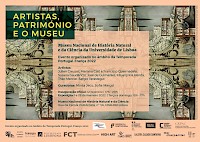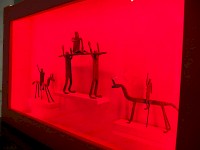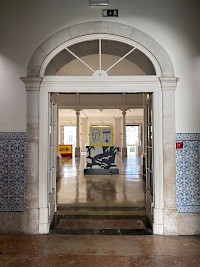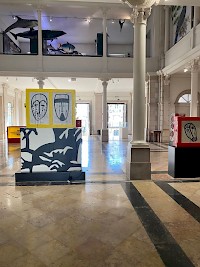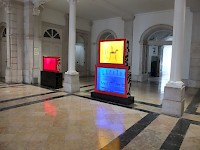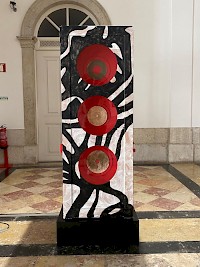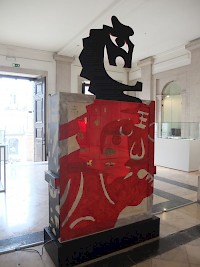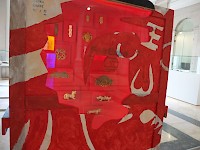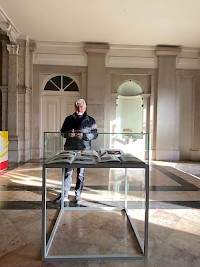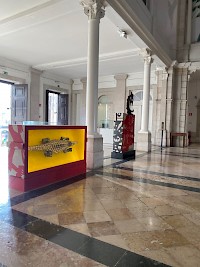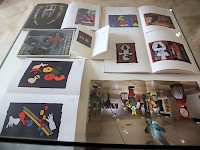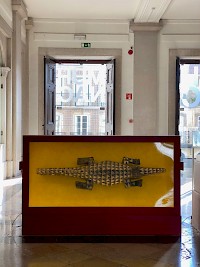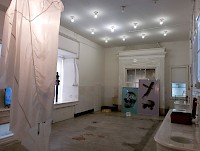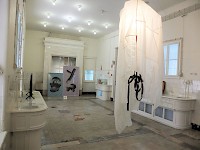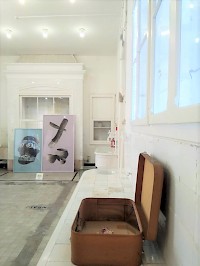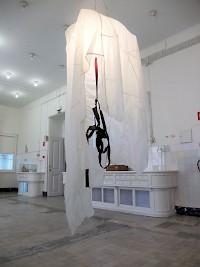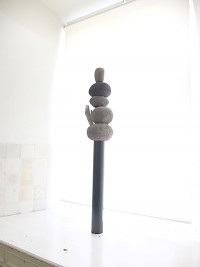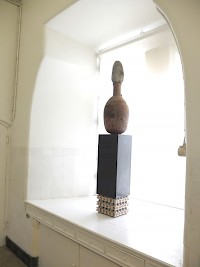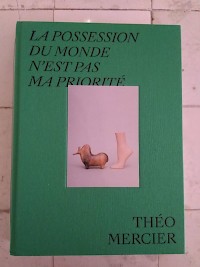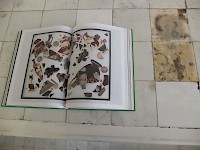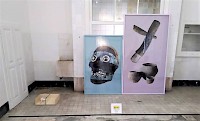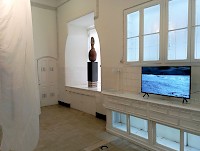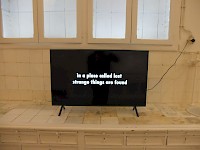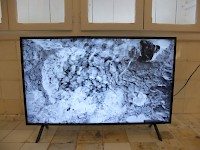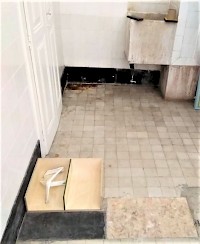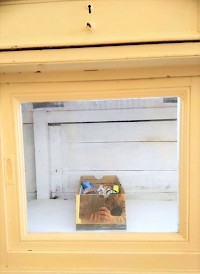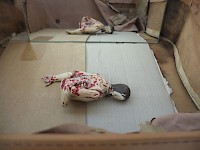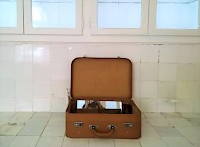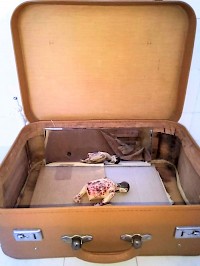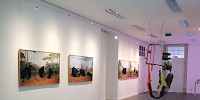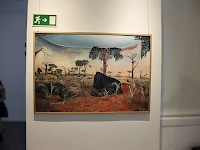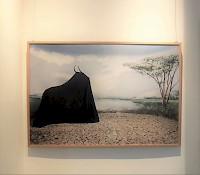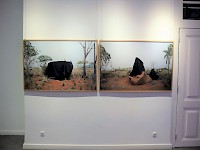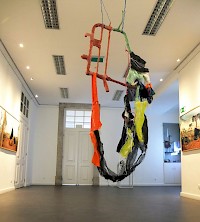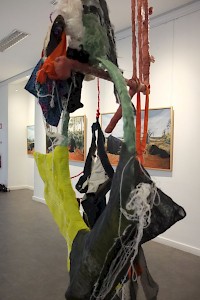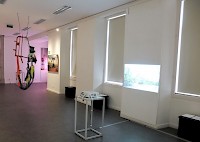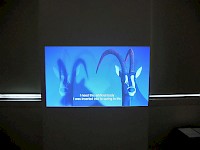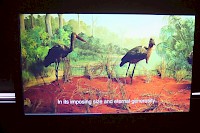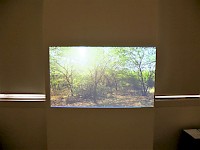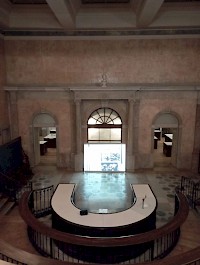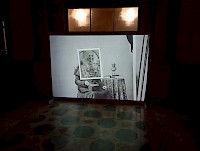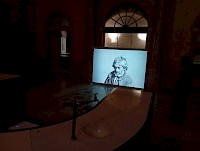Exhibition
ARTISTS, HERITAGE AND THE MUSEUM
An event of the France-Portugal Season 2022
1st-28th February 2022
Museu de Historia Natural, Lisboa
Artists
José de Guimarães; Julien Creuzet; Kiluanji Kia Henda;
Mariana Caló e Francisco Queimadela; Sergio Verastegui; Susana Gaudêncio e Théo Mercier
Curator: Marta Jecu, Sofia Marçal
Inserted into the official calendar of the France-Portugal 2022 Season, this initiative bears the seal of the CeiED - Interdisciplinary Research Centre for Education and Development, Universidade Lusofona and the official partner of the French-Portuguese partnership. The Portugal-France Season 2022 is a bilateral diplomacy initiative between Portugal and France, which aims to deepen cultural relations between these two countries.
In the context of a recent preoccupation with non-European heritage, the history of scientific museology and the colonial and postcolonial thought associated with it, the institution museum and the way in which it frames history, have been intensely scrutinized. This group exhibition and associated events analyze with a multidisciplinary and dynamic methodology museums as a means of viewing heritage through the lens of contemporary art. The exhibition is a reflection on the question of heritage – personal, global, collective – and aims to reflect on museums as a 'media' to read history. This exhibition initiated with the observation that contemporary art has integrated this "media" and gradually reformed and democratized "the museological device". The exhibition proposes that especially conceptual art had an important role to play in the field of new museology: as a creative factor which, once introduced into museums it became a tool for rethinking and de-colonising the museological display. The project therefore aims to map and theorize emerging methodologies that engage contemporary art for the reinterpretation of the "museological device".
The colonial heritage and the fusion between European and non-European art has been an imperative concern in both Portugal and France. In this context of ideas, this exhibition also aims to serve as a tribute to the vast and inspiring work of José de Guimarães. One of the great Portuguese artists with an extremely diverse and prolific work, he marked the history of contemporary art since the 1960s. His first solo show in Paris was in 1979, followed by several exhibitions around the world.
He opened a field of practice in which artistic objects merge with ethnographic material, in the sense of a non-hierarchical and fusional link between European and non-European heritage. The project intends to interpret his work in the context of the new museological practices, to which he contributed through his artistic work.
In his set of works exhibited in the Atrium 'Dioramas' the fusion between contemporary art and museologic object reinvent this initial form of a museum and generate a new proposal of what museologic display could be. He founded a museum – CIAJG (Centro Internacional de Arte José de Guimarães) – with an innovative format where his collections of prehistoric Chinese, African and Precolumbian art are made available to artists, for them to develop new works through research and creative residencies. The video work by Mariana Caló and Francisco Queimadela included in this exhibition (exhibited at the Anfiteatro) is the result of a residency at the CIAJG.
The project aims to monitor the way in which this scope of ideas manifests itself in the work of young Portuguese and French artists and aims to crystallize different working methods around these issues.
Kiluanji Kia Henda also works on the diorama model in the staging of a colonial natural history museum in Luanda. Hybrid objects of a creole identity are present in the works of Théo Mercier, Susana Gaudencio and Julien Creuzet, which question the principles of value attribution and of inclusion into an European 'heritage'. Sergio Verastegui's alegories of museum 'boxes' are also a means to de-colonise the way in which museums form the view of their audience upon objects.
This project is understood as an exercise in working with contemporary art for the development of versatile solutions and new information transmission devices that formulate new, possible proposals for museums.
The exhibition is part of a bilateral multidisciplinary project (organized by Marta Jecu with the support of CeiED, Centro Interdisciplinar de Educação e Desenvolvimento, Universidade Lusofona, Lisboa), which is integrated and co-supported by the France-Portugal Season 2022. The bilateral project includes the following EVENTS in 2022: 1. Educational program for the general public, with members of the Department of Museology of the Universidade Lusófona. MUHNAC Lisbon | February 20-28, 2022 2. Conference at the Fondation Maison des Sciences de l'Homme (FMSH), Paris with French researchers and students from this institution and the Universidade Lusofona Lisboa, opening up the cross-cutting issue of contemporary art as a tool for rethinking heritage. FMSH Paris, October 3-7, 2022 3. Performative events and conversations in Arles, organized in collaboration with the HighArt gallery, Paris/Arles. Arles | July 2022 4. Publication/catalogue, with artistic and research material. A collaboration of the Department of Museology of the Universidade Lusófona Lisboa, CeiED Universidade Lusofona Lisboa, La Fondation Maison des Sciences de l'Homme (FMSH), Paris 5. Raphael Grisey's Art Residence, referring to the Botanical Garden's collection of plants and seeds. MUHNAC | April 2022.
PARTNERS:
CeiED, Interdisciplinary Research Centre for Education and Development, Universidade Lusofona, Lisboa, https://www.ceied.ulusofona.pt/en/
Departamento de Museologia, Universidade Lusofona, Lisboa, http://www.museologia-portugal.net/
Museu Nacional de História Natural e da Ciência da Universidade de Lisboa, Lisboa, https://www.museus.ulisboa.pt/
FMSH, Fondation Maison des Sciences de l'homme (FMSH), Paris, https://www.fmsh.fr/en
Galerie High Art, Paris/Arles, https://highart.fr/info/
Galerie Mor Charpentier, Paris, https://www.mor-charpentier.com/
Galeria Filomena Soares, Lisboa, http://gfilomenasoares.com/
Galería Casado Santapau, Madrid, https://casadosantapau.com/
Ocupart - Arte em Espaços Improváveis, Lisboa - https://ocupart.pt
Saison France-Portugal 2022, https://culturaportugal.gov.pt/pt/saber/2021/09/temporada-cruzada-portugal-franca-2022/
ARTISTS:
JOSÉ DE GUIMARÃES (born 1939, Guimarães) is an important presence in Portuguese culture who breaks down the boundaries between disciplines. He is an artist and collector and merges in his own artistic practice painting, sculpture and installation as well as ethnological material that he has collected over time. JULIEN CREUZET (born in Paris, 1986) analyzes the definitions and limits of the cultural and material object and reworks form and content in a way that diversifies the monolithic transmission of history and creates new possible configurations and options, de-materializing museums. KILUANJI KIA HENDA, (ANGOLA, 1978) In his multimedia work, Kia Henda rethinks history, whether through sculpture, installation, video and photography, and his large-scale installations. Parallel narratives that hijack the story of his native Angola with alternate storylines are present in the works in this exhibition that problematise the "Musealisation of Angolan Culture". Humor and storytelling are an integral part of his work and the public is confronted with an augmented reality. MARIANA CALÓ & FRANCISCO QUEIMADELA (1984, 1985 PORTUGAL) The Artist Duo has received numerous national and international awards since 2010. Their work is both critical and poetic. Luminous Shadow was born out of an artistic residency developed in close proximity to the collection of the José de Guimarães International Arts Center. Through the manipulation of images and sounds from the Centre's exhibitions, catalogs and conversations, an experimental language is assembled, seeking to establish a recombination of times and contexts. SERGIO VERASTEGUI, (Peru/FR. , born 1981). In his complex work, the artist deconstructs the “museum”, analyzing its roots. He also works on the architecture and the urban position of the museum from a historical perspective. In this set of objects, he cites different forms of "display" e and reflects on Modernism's contestation of the institution museum through the invention of portable and personal museums. SUSANA GAUDENCIO (born in 1978). Her work is generally research-based and combines intricate drawing, photo-montage and animation, made by modifying personal images and found footage. Her projects elaborate on artistic production as a platform for finding new possibilities to question utopia, as a critical device. THEO MERCIER (born 1984, Paris) Over the past 10 years, the artist has developed, sculpture,installation and found objects, based on surreal and dreamlike imagery populated by unique, mysterious and often monstrous creatures. Most of Théo MERCIER's pieces result from a process of anthropomorphizing objects, mixing the mineral, vegetal, human and animal perspectives and creating hybrid fusions. He invents a new social hierarchy, which defies the notion of 'value'.
